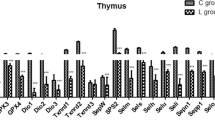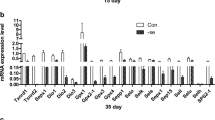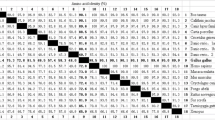Abstract
Selenoproteins and selenium (Se) play important roles in the immune system. Selenoprotein expression in the immune system of mammals is sensitive to dietary Se levels; however, little is known about the expression of selenoproteins and their immune functions in the chicken thymus. We assessed selenoprotein gene expression and cytokine content in the chicken thymus in this study. The animals were randomly assigned to two groups as follows: the Se-deficient group (L group) was fed a diet containing 0.033 mg Se/Kg, and the control group was fed the same basal diet supplemented with Se at 0.15 mg/kg (sodium selenite). Real-time qPCR was used to investigate the expression level of selenoproteins on days 15, 25, 35, 45, and 55, and ELISA was used to evaluate the cytokine content on days 15, 35, and 55. The messenger RNA (mRNA) levels of Txnrd1, Txnrd2, Txnrd3, Dio1, Dio2, Dio3, GPx1, GPx2, GPx3, Gpx4, Sepp1, Selo, Sep15, Sepx1, Sels, Seli, Selu, Selh, and SPS2 were all significantly decreased (P < 0.05) in the L group compared to the control group. A significant decrease in IL-2, IL-10, IL-17, IL-1β, IFN-α, and IFN-β was observed in the L group, and there was also a significant increase in IL-6, IL-8, IFN-γ, and TNF-α in the L group. In summary, Se deficiency results in significant changes in the expression of selenoproteins, which may cause oxidative stress in the chicken thymus tissue. Moreover, immunological changes and immune stress may occur because of Se deficiency in the chicken thymus.



Similar content being viewed by others

References
Loflin J, Lopez N, Whanger PD et al (2006) Selenoprotein W during development and oxidative stress. J Inorg Biochem 100:1679–1684
Zhang ZW, Wang QH, Zhang JL et al (2012) Effects of oxidative stress on immunosuppression induced by selenium deficiency in chickens. Biol Trace Elem Res 149:352–361
Huang Z, Rose AH, Hoffmann PR (2012) The role of selenium in inflammation and immunity: from molecular mechanisms to therapeutic opportunities. Antioxid Redox Signal 16:705–743
You L, Liu C, Yang ZJ et al (2014) Prediction of selenoprotein T structure and its response to selenium deficiency in chicken immune organs. Biol Trace Elem Res 160:222–231
Kryukov GV, Castellano S, Novoselov SV et al (2003) Characterization of mammalian selenoproteomes. Science 300:1439–1443
Mariotti M, Ridge PG, Zhang Y et al (2012) Composition and evolution of the vertebrate and mammalian selenoproteomes. PLoS One 7:e33066
Yao HD, Liu W, Zhao WC et al (2014) Different responses of selenoproteins to the altered expression of selenoprotein W in chicken myoblasts. Rsc Adv 4:64032–64042
Yao HD, Wu Q, Zhang ZW et al (2013) Gene expression of endoplasmic reticulum resident selenoproteins correlates with apoptosis in various muscles of se-deficient chicks. J Nutr 143:613–619
Yao HD, Wu Q, Zhang ZW et al (2013) Selenoprotein W serves as an antioxidant in chicken myoblasts. Biochim Biophys Acta 1830:3112–3120
Lin SL, Wang CW, Tan SR et al (2014) Selenium deficiency inhibits the conversion of thyroidal thyroxine (T4) to triiodothyronine (T3) in chicken thyroids. Biol Trace Elem Res 161:263–271
Zhao X, Yao H, Fan R et al (2014) Selenium deficiency influences nitric oxide and selenoproteins in pancreas of chickens. Biol Trace Elem Res 161:341–349
Liang Y, Lin SL, Wang CW et al (2014) Effect of selenium on selenoprotein expression in the adipose tissue of chickens. Biol Trace Elem Res 160:41–48
Pighetti GM, Eskew ML, Reddy CC et al (1998) Selenium and vitamin E deficiency impair transferrin receptor internalization but not IL-2, IL-2 receptor, or transferrin receptor expression. J Leukoc Biol 63:131–137
Brigelius-Flohe R, Banning A, Kny M et al (2004) Redox events in interleukin-1 signaling. Arch Biochem Biophys 423:66–73
Sheng PF, Jiang Y, Zhang ZW et al (2014) The effect of Se-deficient diet on gene expression of inflammatory cytokines in chicken brain. Biometals 27:33–43
Pappas AC, Zoidis E, Surai PF et al (2008) Selenoproteins and maternal nutrition. Comp Biochem Physiol B Biochem Mol Biol 151:361–372
Lescure A, Rederstorff M, Krol A et al (2009) Selenoprotein function and muscle disease. Biochim Biophys Acta 1790:1569–1574
Hoffmann PR (2008) Selenium and asthma: a complex relationship. Allergy 63:854–856
Liu CP, Fu J, Lin SL et al (2014) Effects of dietary selenium deficiency on mRNA levels of twenty-one selenoprotein genes in the liver of layer chicken. Biol Trace Elem Res 159:192–198
Sunde RA, Hadley KB (2010) Phospholipid hydroperoxide glutathione peroxidase (Gpx4) is highly regulated in male turkey poults and can be used to determine dietary selenium requirements. Exp Biol Med (Maywood) 235:23–31
Kim KH, Gao Y, Walder K et al (2007) SEPS1 protects RAW264.7 cells from pharmacological ER stress agent-induced apoptosis. Biochem Biophys Res Commun 354:127–132
Ye Y, Shibata Y, Yun C et al (2004) A membrane protein complex mediates retro-translocation from the ER lumen into the cytosol. Nature 429:841–847
Yao H, Zhao W, Zhao X et al (2014) Selenium deficiency mainly influences the gene expressions of antioxidative selenoproteins in chicken muscles. Biol Trace Elem Res 161:318–327
Kiremidjian-Schumacher L, Roy M (1998) Selenium and immune function. Z Ernahrungswiss 37(Suppl 1):50–56
Hoffmann PR (2007) Mechanisms by which selenium influences immune responses. Arch Immunol Ther Exp (Warsz) 55:289–297
Kiremidjian-Schumacher L, Roy M, Wishe HI et al (1992) Regulation of cellular immune responses by selenium. Biol Trace Elem Res 33:23–35
Liu LL, Zhang JL, Zhang ZW et al (2014) Protective roles of selenium on nitric oxide-mediated apoptosis of immune organs induced by cadmium in chickens. Biol Trace Elem Res 159:199–209
Zhang ZW, Zhang JL, Gao YH et al (2013) Effect of oxygen free radicals and nitric oxide on apoptosis of immune organ induced by selenium deficiency in chickens. Biometals 26:355–365
Bonham M, O'Connor JM, Hannigan BM et al (2002) The immune system as a physiological indicator of marginal copper status? Br J Nutr 87:393–403
Peng X, Cui H, Yuan J et al (2011) Low-selenium diet induces cell cycle arrest of thymocytes and alters serum IL-2 content in chickens. Biol Trace Elem Res 144:688–694
Netea MG, Joosten LA, Lewis E et al (2006) Deficiency of interleukin-18 in mice leads to hyperphagia, obesity and insulin resistance. Nat Med 12:650–656
Hangalapura BN, Kaiser MG, Poel JJ et al (2006) Cold stress equally enhances in vivo pro-inflammatory cytokine gene expression in chicken lines divergently selected for antibody responses. Dev Comp Immunol 30:503–511
Crhanova M, Hradecka H, Faldynova M et al (2011) Immune response of chicken gut to natural colonization by gut microflora and to Salmonella enterica serovar enteritidis infection. Infect Immun 79:2755–2763
Ye P, Rodriguez FH, Kanaly S et al (2001) Requirement of interleukin 17 receptor signaling for lung CXC chemokine and granulocyte colony-stimulating factor expression, neutrophil recruitment, and host defense. J Exp Med 194:519–527
Zhao FQ, Zhang ZW, Yao HD et al (2013) Effects of cold stress on mRNA expression of immunoglobulin and cytokine in the small intestine of broilers. Res Vet Sci 95:146–155
Sheridan PA, Zhong N, Carlson BA et al (2007) Decreased selenoprotein expression alters the immune response during influenza virus infection in mice. J Nutr 137:1466–1471
de Andres C, Aristimuno C, De Las Heras V et al (2007) Interferon beta-1a therapy enhances CD4+ regulatory T-cell function: an ex vivo and in vitro longitudinal study in relapsing-remitting multiple sclerosis. J Neuroimmunol 182:204–211
Wang CX, Shuaib A (2002) Involvement of inflammatory cytokines in central nervous system injury. Prog Neurobiol 67:161–172
Olson TS, Reuter BK, Scott KG et al (2006) The primary defect in experimental ileitis originates from a nonhematopoietic source. J Exp Med 203:541–552
Yeh HY, Winslow BJ, Junker DE et al (1999) In vitro effects of recombinant chicken interferon-gamma on immune cells. J Interferon Cytokine Res 19:687–691
Rabinovitch A (1994) Immunoregulatory and cytokine imbalances in the pathogenesis of IDDM. Therapeutic intervention by immunostimulation? Diabetes 43:613–621
Liu C, Li M, Cao Y et al (2014) Effects of avermectin on immune function and oxidative stress in the pigeon spleen. Chem Biol Interact 210:43–50
Zeng J, Zhou J, Huang K (2009) Effect of selenium on pancreatic proinflammatory cytokines in streptozotocin-induced diabetic mice. J Nutr Biochem 20:530–536
Simpson RJ, Hammacher A, Smith DK et al (1997) Interleukin-6: structure-function relationships. Protein Sci 6:929–955
Hinton DM, Myers MJ, Raybourne RA et al (2003) Immunotoxicity of aflatoxin B1 in rats: effects on lymphocytes and the inflammatory response in a chronic intermittent dosing study. Toxicol Sci 73:362–377
Li Y, Ma QG, Zhao LH et al (2014) Effects of lipoic acid on immune function, the antioxidant defense system, and inflammation-related genes expression of broiler chickens fed aflatoxin contaminated diets. Int J Mol Sci 15:5649–5662
Lee CC, Kim BS, Wu CC et al (2014) Bursal transcriptome of chickens protected by DNA vaccination versus those challenged with infectious bursal disease virus. Arch Virol 160:69–80
Acknowledgments
The authors thank the members of the Veterinary Internal Medicine Laboratory, College of Veterinary Medicine, and Northeast Agriculture University for their help with sample collection.
Funding
This study was supported by the National Natural Science Foundation of China (Grant No.31472161).
Conflict of Interest
The authors declare that they have no conflicts of interest.
Author information
Authors and Affiliations
Corresponding author
Rights and permissions
About this article
Cite this article
Khoso, P.A., Yang, Z., Liu, C. et al. Selenium Deficiency Downregulates Selenoproteins and Suppresses Immune Function in Chicken Thymus. Biol Trace Elem Res 167, 48–55 (2015). https://doi.org/10.1007/s12011-015-0282-y
Received:
Accepted:
Published:
Issue Date:
DOI: https://doi.org/10.1007/s12011-015-0282-y



